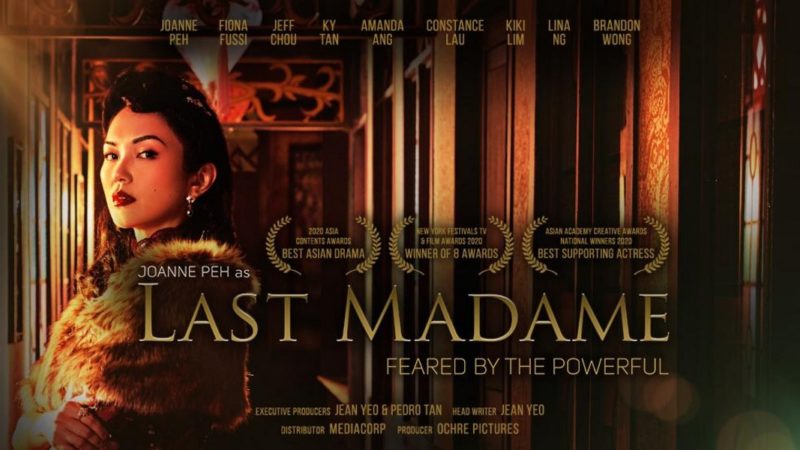Last Madame: An Identity Boost To Southeast Asian
Singapore’s television production Last Madame is Ochre Pictures’ most daring work to date, its candor and imagination give rise to regional talents of South and Southeast Asia.
Singapore’s television production Last Madame is Ochre Pictures’ most daring work to date, its candor and imagination give rise to regional talents of South and Southeast Asia.

Last Madame is produced by Ochre Pictures and Mediacorp. Image courtesy of Mediacorp. Music Press Asia
Ochre Pictures, a Singapore-based television and film production company, has recently caught the attention of arbiters of the television world in Southeast Asia after publishing their very first *M18 series, Last Madame. With awards and nominations already listed for 2020, this production is a gripping story set in 1940s Singapore; a time in history widely known when enigmatic power of the British colonial rule was increasingly jeopardized by news of a rising island nation in East Asia, Japan.
The production sets two parallel worlds unraveling its secrets and mysteries of a run-down shophouse in Singapore. Chi Ling, a character played by Fiona Fussi in present Singapore, begins to unravel a fascinating past burying secrets of a great grandmother she hardly knew; whose role, in all seriousness, is to play the head of house running a brothel.
Focusing on the geographical and historical context so rarely depicted in the global screen of television series, Last Madame represents a maturing genre truly distinct of identities so inconspicuously flourishing in this part of the world.
- Soundtrack: “Ode of the Phoenix”.
- Format: TV Series 2019
- Composer, Arranger & Guitar: Daniel Chai
- Cello: Tang Jia
- Production: Ochre Pictures
- Mixing & Sound Design: Mediacorp Audio Post
- Writers: Jean Yeo (Director), Bernice Low
- Actors: Joanne Peh, Fiona Fussi, Jeff Chou, Lina Ng, Brandon Wong
While the flow of conversations between the characters sounded as if it’s being written through melodramatics and slang common to the region of Southeast Asia then. It was also cleverly dramatized with a fluid language; interchangeably mixing Cantonese, a common Chinese dialect originally from Hong Kong and southern China, with English mainly used to push the story line forward.
Understanding why a dialect originally from Canton is weaved with mainly English may even confuse the best students of anthropology. But the series’ attempt to stamp a preserving identity, mainly of traders and explorers who’d settled in Southeast Asia and eventually created a sub-community in this tropical territory, has greatly highlighted a historical context of human migration. Here it is a region geographically known as the south entry point of the narrow sea-stretch of the Straits of Malacca, a passage for seafarers to hide from rough and high-pressured winds.
It is also where the word ‘heritage’ began its residency; a contextual practice that exists to this day and remain a vital part of its identity where converging cultures play a role determining social norms and pressures of its local economy against global challenges. The story line harks at the rich, colonial architecture that is still being preserved in present Singapore under its very own National Heritage Board.
Singapore, in all its historical splendor, was a grand nautical stop for those traveling from South China Sea westward towards the Indian Ocean – an alternative route, just longer, along the Spice route. Today, it has preserved its dignity, creatively, as a prominent hub for world class productions fueled by a young work force willing to take a stand for an identity that bears no resemblance anywhere else and unique only of Southeast Asian.
Acquiescent to its influence of modern expressionism of productions from the western hemisphere, it lacks rectitude of a style that is progressively maturing. Phrases such as portrayed by Lina Ng, the servant: “This will be the death of me” is surely a cushioned interpretation of how it sounds if spoken in Cantonese.
Uniquely researched and daring, Last Madame has greatly portrayed a brilliant group of young talents worthy of recognition wider than what it has already amassed today. Produced in partnership with and support from Infocomm Media Development Authority (IMDA), this is truly a Singaporean production at its finest. IMDA represents a robust selection of over 730 hours of stories from Singapore and Asia, spanning over 135 titles and genres was part of ATF Online, a Singapore Media Festival last December.
Last Madame is now available on ASTRO on Demand, is distributed by Mediacorp.
* for mature audience restricted to 18 years and above. (Singapore censorship)
Related topic:
The center for Asian American Media (CAMM) is celebrating CAAMFest 2021 on 13-23 May 2021, a 11-day event that showcases new Asian American and Asian film, food and music programmes. And was formerly known as the San Francisco International Asian American Film Festival (SFIAAFF).
CAMM now represents production titles including Ritoma by Ruby Yang; Jim Choi’s documentaries; and Loni Ding’s historical depictions. Latest funded projects: Bloodline directed by Santhosh Daniel and James Q. Chan; Pandemic 19 directed by Yung Chang and Annie Katsura Rollins.




